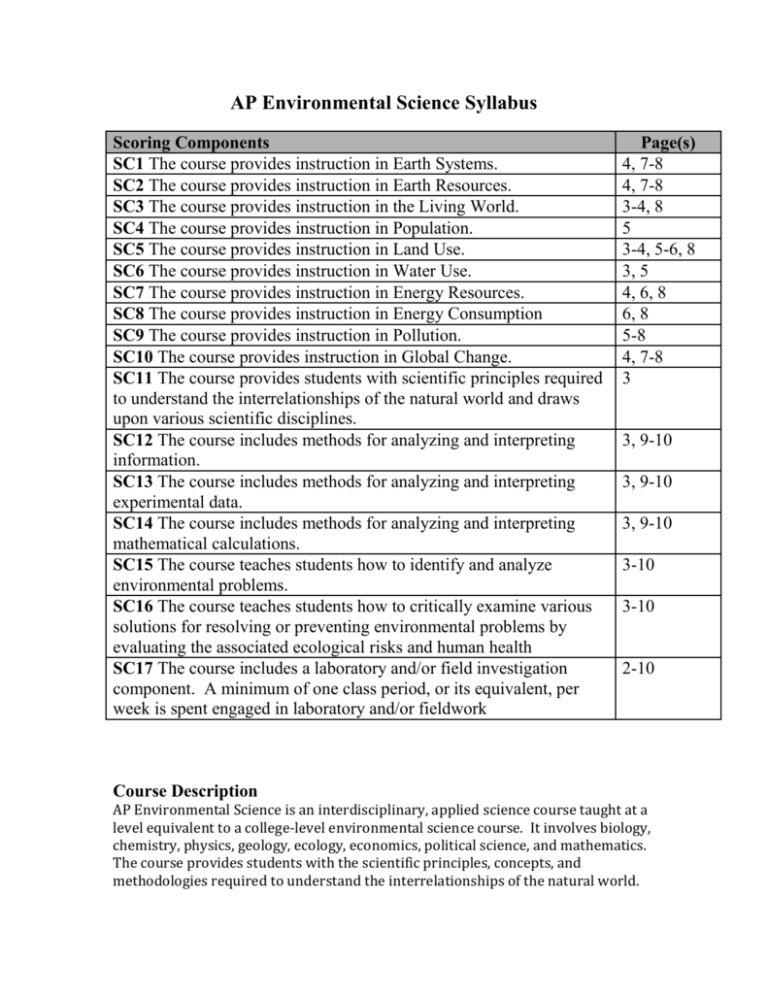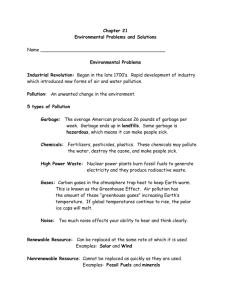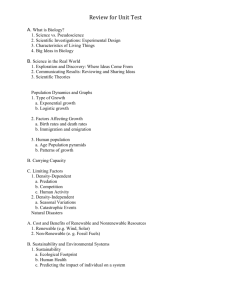Unit 10
advertisement

AP Environmental Science Syllabus Scoring Components SC1 The course provides instruction in Earth Systems. SC2 The course provides instruction in Earth Resources. SC3 The course provides instruction in the Living World. SC4 The course provides instruction in Population. SC5 The course provides instruction in Land Use. SC6 The course provides instruction in Water Use. SC7 The course provides instruction in Energy Resources. SC8 The course provides instruction in Energy Consumption SC9 The course provides instruction in Pollution. SC10 The course provides instruction in Global Change. SC11 The course provides students with scientific principles required to understand the interrelationships of the natural world and draws upon various scientific disciplines. SC12 The course includes methods for analyzing and interpreting information. SC13 The course includes methods for analyzing and interpreting experimental data. SC14 The course includes methods for analyzing and interpreting mathematical calculations. SC15 The course teaches students how to identify and analyze environmental problems. SC16 The course teaches students how to critically examine various solutions for resolving or preventing environmental problems by evaluating the associated ecological risks and human health SC17 The course includes a laboratory and/or field investigation component. A minimum of one class period, or its equivalent, per week is spent engaged in laboratory and/or fieldwork Page(s) 4, 7-8 4, 7-8 3-4, 8 5 3-4, 5-6, 8 3, 5 4, 6, 8 6, 8 5-8 4, 7-8 3 3, 9-10 3, 9-10 3, 9-10 3-10 3-10 2-10 Course Description AP Environmental Science is an interdisciplinary, applied science course taught at a level equivalent to a college-level environmental science course. It involves biology, chemistry, physics, geology, ecology, economics, political science, and mathematics. The course provides students with the scientific principles, concepts, and methodologies required to understand the interrelationships of the natural world. G. Tyler Miller’s Living in the Environment: Principles, Connections, and Solutions, 12th edition, Brooks/Cole/Cengage Learning, 2000, will be used. Instruction consists mostly of lectures, discussions, demonstrations, research projects, in-class assignments, and laboratory investigations. Students will be assessed using a variety of methods, including weekly quizzes, unit tests, formal lab write-ups, oral reports, and homework. Class Size and Scheduling Class size is held to a maximum of 28 students. Classes meet every day for 90 minute blocks, with an additional 60 minutes of instructional focus time four days a week. The block scheduling, as well as the instructional focus time, will ensure students will have a minimum of one hands-on/laboratory experience per week. Students will be enrolled in the class for one semester. Course Prerequisites and Requirements AP Environmental Science is open to all students that have successfully completed Biology and/or Chemistry. Students may take this course concurrently with Honors Chemistry and those students have to have the instructor’s permission to do so. Many students take this course and AP Chemistry and/or AP Physics at the same time. Students should be motivated learners and should be capable of reading a college-level textbook. Environmental Science Curricular Requirements The course provides instruction in each of the following seven content areas outlined in the AP Environmental Science Course Description: I. Earth Systems and Resources (10-15%) II. The Living World (10-15%) III. Population (10-15%) IV. Land and Water Use (10-15%) V. Energy Resources and Consumption (10-15%) VI. Pollution (25-30%) VII. Global Change (10-15%) Unit 1: Review of Science Habits of Mind and Environmental Science Overview Chapter 2: Science Systems Topic: The scientific method, and general overview of best practices for students to use throughout the semester Lab: Scientific Measurements, Precision and Accuracy Lab - uses the scientific method to clarify the relationship of various characteristics of the human body to one another. Students will be asked to hypothesize relationships between different anatomical parts, collect data to test their hypothesis, analyze the data with statistical tests, and reach conclusions about their hypothesis. Environmental Skills Activity - students work with metric units, review the purpose of lab work and general lab methods, and create and analyze graphs from collected data. Chapter 1: Environmental Issues, Experimentation and Statistics A. Introduction to Environmental Science B. General overview of the topics covered throughout the year Lab: Exponential Growth—A Toss of the Dice: Using random throws of dice, this activity simulates population growth of a species. Factors such as life span, birthrate, resource depletion, and population momentum are explored. Probability, and statistics are introduced to the study of ecology. Video: The Rise of Ecology Chapter 2: Environmental History A. How humans have adapted to and modified the environment B. Environmental history of the United States Activity: Ecological Footprint - allows students to keep track of their ecological footprint for one week. Students will use this data to extrapolate their annual CO2 emissions. Video: The Lorax Internet Activity: Top Environmental Stories, 1970-2000 Unit 2: Introduction to the Living World [SC3] Chapter 3: Matter and Energy A. Nature’s building blocks—a review of general chemistry Macromolecule Lab B. Different forms of energy and their importance in environmental science C. Laws of matter and energy Chapter 4: Ecosystems: Components, Energy Flow, and Matter Cycling A. Populations, communities, food chains, and webs Ecocolumns Lab (15-week lab) - provides opportunities to investigate the components of different ecosystems in miniature. The conditions required for the sustainability of the ecosystems, and the interconnections between them will be studied. This is a long-term study that will not be completed until the midDecember. Owl Pellet Lab B. Ecological pyramids and productivity Eating Lower Lab - students calculate and compare food needs at different trophic levels, construct a biomass pyramid from data, and analyze and evaluate the benefits and drawbacks of eating at lower trophic levels on a global scale C. Biogeochemical cycles Lab: Aquarium Nitrogen Cycle Chapter 5: Evolution and Biodiversity: Origins, Niches, and Adaptation A. Micro- and macroevolution Wooly Worm Lab B. Niches—fundamental and realized, generalists and specialists C. Theories and misconceptions about evolution Chapter 6: Biogeography: Climate, Biomes, and Terrestrial Biodiversity A. Weather and climate Internet Activity: Creating and Understanding Climatograms B. What are biomes and how do they differ? Lab: Biodiversity in Leaf Litter: A Berlese funnel is used to collect organisms from leaf litter. Biodiversity is calculated using the Shannon- Weiner Diversity Index. Internet Activity: Biome Webquest Video: The Rainforest (National Geographic) Chapter 7: Aquatic Ecology: Biodiversity in Aquatic Systems A. Saltwater life zones B. Freshwater life zones Video: Aquatic Life Zones Unit 3: Populations [SC4] Chapter 8: Communities A. Nonnative or exotic species B. Indicator species and keystone species C. Interspecific and intraspecific competition Lab: Inter-and Intraspecific Competition: Students analyze the effects of population density on the growth of two plant species (radishes and collards) growing alone and in mixed species groups. Density and species composition are manipulated. The resulting biomasses of the two species are statistically analyzed. Virtual Lab: Pearson Competition Lab D. Competition and symbiosis Video: Cane Toads E. Succession Chapter 9: Populations A. Exponential versus logistic growth Lab: Duckweed Population Growth Lab: Students observe the growth of duckweed, an aquatic f loating plant, and how its growth rate yields a logistic B. curve, illustrating concepts of population growth rates, carrying capacity, and limiting factors (such as light, pH, etc.). C. Biotic potential and environmental resistance D. Characteristics of r-strategists and K-strategists E. Survivorship curves Chapter 11: The Human Population: Growth, Demography, and Carrying Capacity A. Zero population growth Video: The People Bomb Video:WorldPopulation(ZeroPopulationGrowth) B. Fertility and death rates Field Trip Option: Cemetery Population Study C. Age structure histograms Lab: Power of the Pyramids—Constructing Age-Sex Histograms: Students use census data to construct age-sex population pyramids. Such pyramids, representing several countries in various stages of development, are discussed and compared. Students then explore and discuss how the population would be affected by factors such as natural and human-made disasters as well as social, economic, and political changes. D. Factors affecting population size E. The demographic transition Unit 4: Earth Systems Chapter 10: Geology: Processes, Hazards, and Soils A. Geologic processes and plate tectonics Virtual Lab: Plate Tectonics B. Erosion and weathering C. Rocks, minerals, and the rock cycle D. Soil formation and soil profiles E. Characteristics of soil and reading a soil triangle Lab: Chemical and Physical Properties of Soils F. Soil erosion, desertification, and salinization Student-Designed Lab: Soil Salinization’s Effect on Seed Germination. Students will be expected to collect and analyze relevant data, draw conclusions about the results, and discuss practical implications of soil salinization for irrigated agriculture. Chapter 14: Geologic Resources: Nonrenewable Mineral and Energy Resources Unit 5: Resources Chapter 12: Food Resources Chapter 13: Water Resources A. B. C. D. E. F. G. H. Properties of Water Types of Freshwater Water Shortages Damming water and water transfer Desalinization Irrigation Solutions to overuse of water Flooding and Floodplain Management Video: Power of Water (National Geographic) Chapter 14: Geologic Resources: Nonrenewable Mineral and Energy Resources A. Identifying, locating, and removing nonrenewable mineral resources 1. Types of mining 2. Environmental effects of mineral extraction B. Oil extraction, refining, and use C. Natural gas D. Coal E. Nuclear energy Chapter 15: Energy Efficiency and Renewable Energy A. Energy efficiency and how to improve it B. Solar energy 1. Passive solar energy 2. Active solar energy C. Hydroelectricity D. Wind power E. Biomass F. Solar-hydrogen G. Geothermal energy H. Micropower I. Sustainable energy use Unit 6: Pollution [SC9] Topic: Air and Air Pollution A. Outdoor air pollution 1. Photochemical and industrial smog 2. Inversions 3. Acid deposition B. Indoor air pollution 1. Types and sources 2. Effects on human health • Lab: Measuring Automobile Pollutants C. Solutions to air pollution Chapter 19 Topic: Water Pollution Main types of water pollutants and how they are measured Point and nonpoint sources of pollution Stream pollution and oxygen-sag curves Groundwater pollution Ocean pollution Wastewater treatment Lab: Measuring Water Quality Chapter 21 Topic: Solid and Hazardous Waste Municipal Solid Waste (MSW) Hazardous waste Reduce, reuse, recycle Detoxifying, burning, burying, and exporting waste Land disposal Laws regarding hazardous waste in the United States Chapter 16: Risk, Toxicology, and Human Health Chapter 17: Air and Air Pollution Chapter 19: Water Pollution Chapter 20: Pesticides and Pest Control Chapter 21: Solid and Hazardous Waste Unit 10: Global Change [SC10] Chapter 18 Topic: Climate Change and Ozone Loss 1. Natural greenhouse effect 2. Global climate change 3. Possible solutions 4. Ozone depletion 1. Causes and chemical reactions 2. Effects on human health Unit 11: Ecological and Human Health Chapter 16 Topic: Risk, Toxicology, and Human Health 1. Risks and hazards 2. To x i c o l o g y 1. Bioaccumulation and biomagnification 2. Poisons C. Chemical hazards D. Transmissible diseases AP Environmental Science: Sample Syllabus 2 SC 10 The course provides instruction in Global Change. F. Risk analysis Chapter 20 Topic: Pesticides and Pest Control 1. Types of pesticides 2. Pros and cons of pesticide use 3. 4. 5. 6. Pesticide treadmill and circle of poison Pesticide regulations in the United States Alternatives to the use of pesticides Integrated pest management Unit 9: Conservation Sequence and Scope: Chapter 22: Sustaining Wild Species Chapter 23: Sustaining Terrestrial Biodiversity: the Ecosystem Approach Chapter 24: Sustaining Aquatic Biodiversity Unit 10: Environment and Society Sequence and Scope: Chapter 26: Economics, Environment, and Sustainability Chapter 27: Politics, Environment, and Sustainability Chapter 28: Environmental Worldview, Ethics, and Sustainability 25: Sustainable Cities: Urban Land Use and Management








